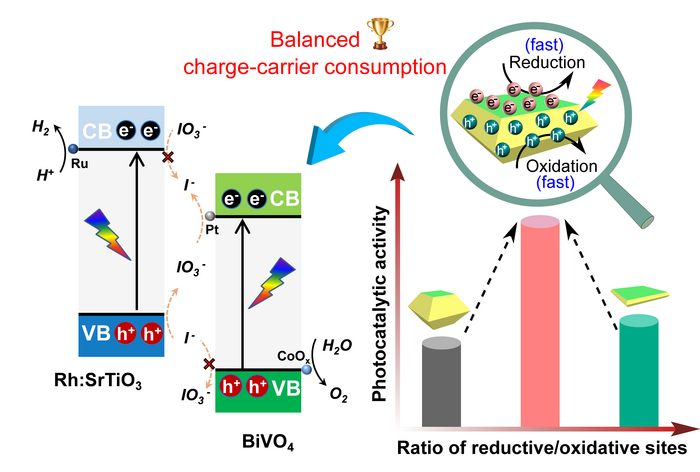For both energy and environmental issues, researchers are interested in the photocatalytic water splitting process. Using light energy and a catalyst, water is split into oxygen and hydrogen. Researchers have looked to hydrogen, a clean-burning fuel, as a renewable energy alternative as global warming increasingly becomes a concern.
 Excellent photocatalytic performance could be realized with accelerated selective redox reactions through balanced charge-carrier consumption. Image Credit: Nano Research
Excellent photocatalytic performance could be realized with accelerated selective redox reactions through balanced charge-carrier consumption. Image Credit: Nano Research
A lot of work has been put into this potential research area over the past few decades because water is such a cheap resource. Scientists, however, have only been able to find a few photocatalysts with high efficiency and exceptional stability.
Therefore, there is still a long way to go before the photocatalytic water splitting technique can be used in real-world applications.
Bismuth vanadate (BiVO4) crystals were successfully used as a photocatalyst by a research team from Xi’an Jiaotong University in China to achieve effective photocatalytic water splitting. Their research demonstrates the strong connection between the surface characteristics of BiVO4 and the acquired photocatalytic activity. On August 15th, 2022, the team’s findings are released in the journal Nano Research.
Separation of the electron-hole pair and their consumption by water oxidation or water reduction reactions taking place on the surface is essential in order for the water splitting process to be efficient. The electron-hole is a charge carrier responsible for creating an electric current in semiconducting materials. Charge-carrier is the name given to a particle that carries an electric charge and moves freely within a material.
By exposing specific facets as enriched reaction sites on the photocatalysts, scientists have been able to achieve excellent performance. Researchers have also discovered that titanium dioxide and strontium titanate, with their exposed facets, offer excellent performance. This knowledge gave scientists insight into the fact that an efficient photocatalytic process could be achieved by tuning the surface of a photocatalyst with different functions.
Researchers found that BiVO4 nanosheets with exposed facets performed exceptionally well for the oxidation of water. According to research, if the BiVO4 facets were made larger, better photocatalytic activity for the oxidation of water might be obtained.
The study team from Xi’an Jiaotong University concentrated on BiVO4 as a representative photocatalyst. They looked at how the consumption of surface charge carriers affected the reactions that split water. The group created BiVO4 single crystals with specifically balanced facets for the oxidative and reductive sites.
They created the BiVO4 crystal under controlled hydrothermal conditions. Through this method, they proved that balanced surface charge-carrier consumption based on a medium ratio of the reductive sites and the oxidative sites is capable of achieving efficient photocatalytic water oxidation.
BiVO4 alone is not sufficient to produce total water splitting when used as a conventional photocatalyst for water oxidation. To further their research, the scientists built a Z-scheme system, which combines two separate photocatalysts.
The team was able to achieve stable and efficient photocatalytic overall water splitting by using the BiVO4 with appropriate cocatalysts.
Superior photocatalytic water oxidation is obtained from BiVO4 decahedrons with a medium ratio between reductive and oxidative sites, which is ascribed to the as-achieved balanced surficial charge-carrier consumption. In addition, efficient and stable photocatalytic overall water splitting is achieved by adopting the as-synthesized BiVO4 decahedrons with suitable cocatalyst modification.
Shaohua Shen, Professor, International Research Center for Renewable Energy, Xi’an Jiaotong University.
“Looking ahead, this work provides both guidance on the fabrication of nano/micro-material with controllable surficial morphology and insightful investigations of the corresponding photocatalytic redox reaction,” said Shen.
The National Natural Science Foundation of China, the National Key Research and Development Program of China, the National Program for Support of Top-notch Young Professionals, the Natural Science Basic Research Program of Shaanxi Province, and the Natural Science Foundation of Jiangsu Province contributed to the study.
Others like the China Postdoctoral Science Foundation, the Fundamental Research Funds for the Central Universities, and The Youth Innovation Team of Shaanxi Universities are among the organizations that have provided funding for the study.
Journal Reference:
Guan, X., et al. (2022) Photocatalytic water splitting on BiVO4: Balanced charge-carrier consumption and selective redox reaction. Nano Research. doi.org/10.1007/s12274-022-4758-8.